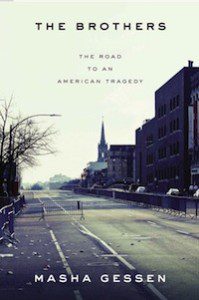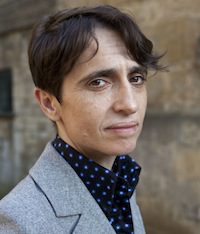
Many emotions were dredged up by testimony in the Dzhokhar Tsarnaev trial, one of the highest-profile domestic terrorism cases in recent memory. Jurors teared up when a medical examiner testified about the death of Krystle Marie Campbell, showing graphic images of the woman’s fatal injuries from the Boston Marathon bombing in 2013. The prosecution had witnesses and victims testify to the carnage of the blast, the FBI showed jurors a model of the pressure cooker bombs that were allegedly used, and the jurors went for an off-site visit to the boat where a bleeding Dzhokhar hid until law enforcement captured him. This painful trial concluded grimly. On Friday, after 14 hours of deliberation over three days, jurors sentenced Dzhokhar to death.
Amid this flood of information comes Masha Gessen’s The Brothers: The Road to An American Tragedy. The book, a media corrective at its most basic, is an antidote to prevailing narratives surrounding the Tsarnaev brothers and the Boston Marathon bombing. It is the kind of book that reminds us that there are two sides to every story—though that’s not to say the pain of those affected by the bombing should be condoned. It’s the kind of book that makes you feel that truth. But ultimately, The Brothers makes one wonder if perhaps a journalist can have too much empathy.
Gessen has made a point of getting the facts right and providing deep historical and cultural context for the lives of Tamerlan and Dzohkhar Tsarnaev. She begins with the love story of Zubeidat and Anzor Tsarnaev, the brothers’ parents, and follows them through their relocation to Kyrgyzstan, then to Dagestan, and finally to the United States, where they eventually gained the right to reside as political asylees. She follows the Tsarnaev brothers as they go to school at Cambridge Rindge and Latin and learn how to wrestle and box and watch their sisters get married as teenage brides. She makes factual corrections along the way—official records do not corroborate that Anzor Tsarnaev was an investigator in a Kyrgyzstani prosecutor’s office, as reported elsewhere—but for the most part, this is a familiar story.
What Gessen adds to the conversation is her deep knowledge of Russia. She was a journalist there for many years; she reported on Chechnya, where Anzor’s family is from; and more recently, she has written a number of books on contemporary Russia, including a biography of Vladimir Putin. This background enables her to provide fresh angles on a chewed-up subject, such as the effect of the bombings on Boston-area Chechens. (Many were interviewed—and some even say harassed—by the FBI following the attack.)
The Brothers makes readers feel the tragedy of the Boston bombing in all its complexity. With all the context Gessen provides—the history of upheaval in Chechnya, the constant terror of life in Dagestan, the family’s inability to find happiness and steady work in America—it’s hard not to feel as if the Tsarnaev brother’s decision to bomb the marathon (which Dzhokhar has admitted to in court) was at least in part the product of historical and cultural forces bearing down on two disenfranchised young men. It’s an unsettling feeling, as someone who two years ago heard cop cars screaming outside her Cambridge apartment, to find oneself, one hundred and fifty pages in, rooting for Dzhokhar to escape from law enforcement. But that’s the magic of this book: it turns two antagonists of American society into protagonists.
But seeing the brothers as tragic figures and, more significantly, empathizing with them as such, comes at some cost to “The Brothers.”
Much of the book’s work is to question the stories we have told ourselves in order to understand what happened on April 15, 2013. Gessen, for example, refutes the radicalization narrative—the idea that Tamerlan and Dzhokhar Tsarnaev were influenced by older, more radical men and that led to the bombing. The person the FBI once believed was a potentially villainous mastermind is really, as she finds, an aging man in a wheelchair. And the person the media has painted as Tamerlan’s radicalizing Muslim guru is actually a soft-spoken man who says he would never have encouraged Tamerlan to commit an act like the Boston bombing.
Then there is the popular notion that Tamerlan was radicalized during his time in Dagestan. Gessen’s research finds that Tamerlan’s links to Dagestani militants are tenuous at best. (They were reported in a notoriously unreliable Russian newspaper, she says.) “In the end it seems that most of what Tamerlan did during his six months in Dagestan was talk,” she writes. But then she does something interesting: she attempts to put herself in Tamerlan’s shoes. She imagines how Tamerlan might have felt in Dagestan, surrounded by like-minded Muslim men. “Talking—and having someone not only listen to what he had to say but also take it seriously enough to question and criticized and try to guide him—was a radically new experience for him.” It is unclear how she has come to this conclusion. It seems like a reasonable assumption, but just that: an assumption.
Empathy is an admirable quality in a journalist. It’s an essential mitigating factor against the problem best articulated, if in exaggerated terms, by Janet Malcolm—that the journalist “is a kind of confidence man preying on people’s vanity, ignorance, or loneliness, gaining their trust and betraying them without remorse.” But in this case, Gessen’s empathy sometimes overtakes her critical distance from her subjects. Gessen doesn’t provide convincing proof that Tamerlan wasn’t radicalized in Dagestan. She argues that if he truly had been radicalized in Dagestan, he would have joined other Dagestani radicals and went down to Syria to fight, or he could have joined Dagestani guerilla fighters in the woods. She’s attempting to prove an argument in the negative. But neither of these options was Tamerlan’s fight. His, as we know, was in America.
Gessen is a Russian-born woman who, like the Tsarnaev brothers, immigrated to the United States as a child, and it is clear that in some cases she recognizes her own experiences in the lives of these young men. When examining how well the FBI knew the Tsarnaevs prior to the attack—they had visited the house multiple times, according to the family—she uses her own experience to argue that it is likely the FBI knew the Tsarnaevs well, despite official statements to the contrary. (Gessen says she received a visit from the FBI upon her arrival in the States.)
This identification, and the empathy that accompanies it (we are, after all, more likely to empathize with those like us), is perhaps what makes Gessen feel comfortable enough to put herself in Tamerlan’s shoes when explaining how his time in Dagestan might have affected him. But it also makes Gessen willing to entertain notions others would not. It likely drives the rampant speculation of the final chapter of the book—speculation so incredible that it nearly undoes all the good work in the preceding chapters. There is, of course, some validity to the points Gessen makes. The FBI’s investigation does seem sloppy—investigators killed an acquaintance of Tamerlan’s; they presented a signed confession full of inconsistencies in court; they targeted seemingly every Chechen Muslim who came in contact with the Tsarnaevs. But it’s unlikely that the FBI is covering up the fact that Tamerlan Tsarnaev was an informant, as she suggests.
The Brothers had the chance to be an exemplar of journalism’s ability to foster empathy, but by the book’s end, it is an example of a journalist’s empathy gone too far.





